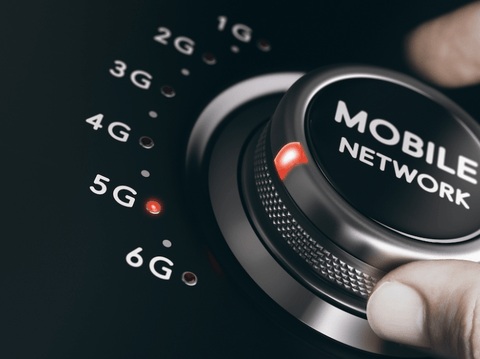5G vs. 4G: What’s the Real Difference? A breakdown of what 5G brings to the table.

Lately, there has been a lot of buzz around 5G and the fact that it is coming soon.
5G is here, it was launched first by MTN in September 2022 in Lagos, Abuja, Port Harcourt, Ibadan, Kano, Owerri, Maidiguri.
Afterward, Airtel also launched in June 2023 in Lagos, Abuja, Rivers, and Ogun. So, it’s not everywhere yet in Nigeria.
Glo is yet to launch their 5G services, but they have deployed LTE Advanced to improve their 4G services.
9mobile’s 5G network is available in Lagos, Nigeria, but then, another research says that 9mobile has not launched yet.
Despite the huge advantages of 5G technology, the adoption rate in Nigeria is very low. Reports from the International Telecommunications Union (ITU) says that the 5G coverage in Nigeria is only 6%, and it is the lowest in the world.
ITU stated that some reasons for the low adoption include the high cost of equipment, devices, routers, and inadequate infrastructure.
Overtime, we have been hearing promises of superfast internet, smart cities, and self-driving cars, thanks to the next generation of tech gurus.
But then, what does this leap from 4G to 5G really mean?
To appreciate its impact, let’s consider or look back at how 4G transformed connectivity and how 5g will do way better.
When 4G launched, it felt like the best thing after Amala and Inu Eran. For the first time in a very long time, we could stream HD videos on our phones, make long video calls, download large files within a few minutes or even seconds.
With the speed of up to 100Mbps, 4G brought mobile Internet up to speed with many home broadband connections. We’re not going to argue with the fact that it was a significant upgrade from 3G.
With 4G, the world felt smaller and even more connected, with different mobile applications booming in almost every sector.
Now 5G, the fifth generation of technology that has promised more dramatic changes is here. 5G has been designed to perform 100 times better than 4G, and it is capable of connecting millions of devices simultaneously.
5G also aims to build a new digital ecosystem. Its features like ultra-low latency, increased energy, and massive bandwidth are not just for fast Internet alone, there’s a goal to redefine what’s possible, from remote surgeries to autonomous vehicles to immersive VR experiences, smart cities, and other beautiful innovations.
5G vs. 4G: What’s the Real Difference?

The whole transition from 4G to 5G has been discussed, but then, what does 5G bring to the table that 4G cannot. I’ll be breaking down some key differences and the impact that 5G can have in our everyday life.
1. Bandwidth and Speed
4G: When 4G was introduced, it offered speed up to 100Mbps, that was a big leap from 4G, making so many internet activities easier and faster.
5G: With its potential speed, 5G is about 100 times faster than 4G, bringing up to 10 GPS speed to the table. This means that, downloading a high definition movie will only take you seconds. Online games, real-time streaming and other Internet activities will be way smoother and faster than ever.
2. Latency
4G: The average latency with 4G is about 50 milliseconds (ms). It is fast, but it is not ideal for certain applications like VR or autonomous vehicles that need instant response.
5G: With 5G, reducing latency to as low as 1ms will enable near instantaneous data transmission. This change is critical, especially for technologies like self-driving cars, remote surgery, and gaming where every millisecond counts.
3. Device Connectivity
4G: It has the capacity to support around 2,000 connected devices per square kilometer. This limitation is already becoming obvious because smart devices such as home assistants, security cameras and IoT gadgets are added to networks.
5G: It has the capacity to support up to 1 million devices per square kilometer. With this, there’s a possibility of connecting a sense network of IoT gadgets without overloading it, giving rooms for advanced industrial applications.
4. Energy Efficiency
4G: It requires more power for its infrastructure, which can place limitations on the battery life of mobile devices and also increase operational expenses for telecoms providers.
5G: With the way it was designed, it is more energy efficient. It allows the network to consume less power while maintaining a high-performance rate. This benefit is important for sustainable tech growth, especially with the innovations of IoT applications.
5. Reliability and Coverage
4G: It offers broad coverage, but it can sometimes struggle in areas with high congestion, such as stadiums or city centers.
5G: It uses higher frequency bands (like millimeter waves) to provide high speeds and reliability in crowded spaces. However, these waves have shorter ranges. This means that the 5G network requires more infrastructure like small cells to ensure consistent coverage.
On a final note, while 4G did so much by revolutionizing mobile internet, 5G has more to bring to the table in terms of connectivity. With the way 5G is designed, it designed to be the backbone of a more connected world. As different technology continue to roll in on a global scale, it will significantly transform how we interact with the digital world and how it interacts with us.
P.S: 6G is already a concept and will be launched in 2030. Presently, programmers from different countries like USA, South Korean, Japan are currently working on it.
